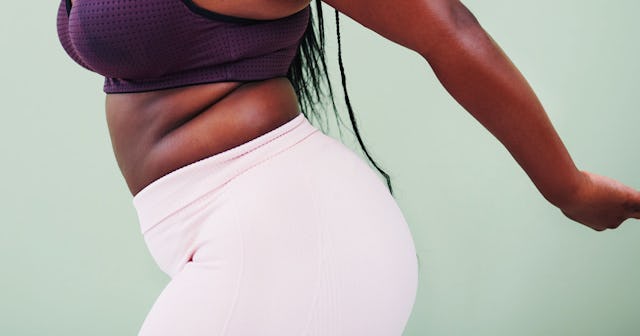There's A Surprising Connection Between Your Hips And Your Emotions

The day of my 40-year-old husband’s funeral is largely a blur. Only a few memories stand out — my daughter telling the nearly 600 attendees about how she liked to play basketball with her dad, the depthless sound of dirt dropping onto a coffin, and the pain. The pain, which was in my heart, and my head, and oddly enough, my hips.
My hips, which had never in my life had pain, suddenly ached. My hips, which had run pain-free miles in the past, which had held me up suddenly couldn’t bear to keep me upright for another moment.
The pain was odd and terrifying. According to experts with a deep understanding of the mind-body connection, it shouldn’t have been too surprising. The hips are a “potential storage vessel of emotions.”
A Quick Primer On Your Hips
Most of us can point to our hips — the area on each side of our pelvis. Most of have a vague understanding of the role the hip joint plays in our daily life.
I’d venture to guess that most of us didn’t know exactly how much is happening around the hip joint. (I didn’t.)
According to Laura Khoudari, CPT, CES, SEP-in-training, author of Lifting Heavy Things: Healing Trauma One Rep At A Time, there’s a lot physiologically happening near the hip joint. She wrote in an email: “The hip joint is where the thigh and pelvis meet and this area of your body holds your weight and stabilizes you no matter if you are still or on the move. There are about twenty muscles surrounding the hip joint. Also the pelvis houses our reproductive and elimination organs.”
With all of that in mind, it’s clear that the hips play an important role in our overall body function.
A Quick Primer On The Mind-Body Connection
Experts have been studying the mind-body connection for decades. In 1985, neuroscientist Candace Pert wrote that “your body is your subconscious mind.”
That statement is supported by current research, as well. A 2020 study found that emotions are experienced in the body in a universal way.
“[W]e physically feel our feelings in our body,” writes Khoudari, who noted the connection between emotional memory and physical response is often present in order to keep us safe. In many ways, it’s a survival mechanism.
It’s why stress can show up in your jaw, as a knot in your shoulder, a tight back, or a (literal) pain in your neck.
The Hips As Storage Vessel Of Emotion
In an article for Healthline, Martha Eddy, a leading somatic educator, author, and founder of Dynamic Embodiment, spoke about the role hips play in our mind body connection. She said, “The pelvis is full of our creative, reproductive organs and contains the centrally located psoas muscle that connects the upper and lower body (the breath and diaphragm to the legs) making the core of our body important both physically and emotionally.”
The psoas is surrounded by the kidneys and the adrenal glands, which control our fight or flight response. When we’re faced with an emotional stressor and our fight or flight response is activated, our psoas muscles tightens in response.
Even after the stressor is gone, the tension may remain in the hips, according to Eddy. That could lead to headaches and lower back pain.
If You’re Feeling Pain In Your Hips
If you’re feeling pain in your hips, particularly a new pain, there are a few things you should do. First, always speak to a medical professional. While the mind-body connection can be one explanation for pain, there may be other underlying factors.
Once a medical professional is consulted, Khoudari urges her clients to “get curious about the pain by asking questions like at what point in a movement does it happen and what is the quality of the pain?” Depending on what the client wants and what she’s seeing, she tries to find either a pain free moment or encourages clients to “explore an emotional connection to the hip through a guided practice or writing reflection.”
Khoudari suggests engaging in regular mindful movement, even if just for a few minutes a few days a week. “Mindfulness has been found to reduce stress, control anxiety, promote emotional health, and control pain. A moving mindfulness practice does this while you cultivate the ability to really notice nuance within the body ultimately deepening your connection to it.” The movement can be anything you’re already doing — chores, your pre-workout warm-up, or even the walk to the train.”
Recently my hips have again started to ache. I’m not surprised by the pain this time — solo parenting two tweens during a pandemic that’s heading into year three; doom scrolling all the political, environmental, and financial uncertainty; and navigating new situations and spaces. But I am more prepared to listen to the pain and honor what my body needs both mentally and emotionally. After I see a doctor, of course.
This article was originally published on